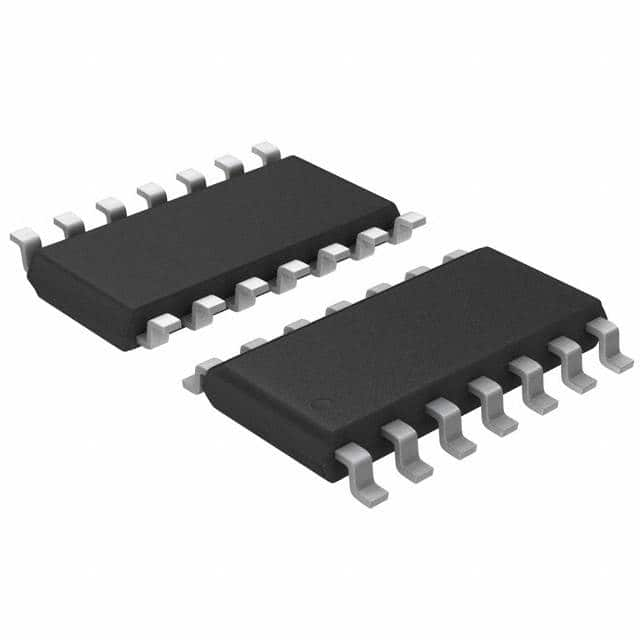MAX491EESD
Product Overview
- Category: Integrated Circuit (IC)
- Use: RS-485/RS-422 Transceiver
- Characteristics: Low-power, half-duplex transceiver with high-speed data rates
- Package: 14-pin, small outline integrated circuit (SOIC)
- Essence: Provides a robust interface between microcontrollers or other digital logic systems and RS-485/RS-422 networks
- Packaging/Quantity: Available in tape and reel packaging, with 2500 units per reel
Specifications
- Supply Voltage Range: +3.0V to +5.5V
- Data Rate: Up to 2.5Mbps
- Operating Temperature Range: -40°C to +85°C
- Number of Drivers/Receivers: 1 Driver, 1 Receiver
- ESD Protection: ±15kV Human Body Model (HBM), ±8kV IEC 61000-4-2 Air-Gap Discharge, ±6kV IEC 61000-4-2 Contact Discharge
Pin Configuration
The MAX491EESD has a total of 14 pins. The pin configuration is as follows:
- DE (Driver Output Enable)
- RE (Receiver Output Enable)
- A (Non-Inverting Driver Input/Receiver Output)
- B (Inverting Driver Input/Receiver Output)
- GND (Ground)
- B (Inverting Driver Input/Receiver Output)
- A (Non-Inverting Driver Input/Receiver Output)
- VCC (Positive Power Supply)
- RO (Receiver Output)
- DI (Driver Input)
- GND (Ground)
- B (Inverting Driver Input/Receiver Output)
- A (Non-Inverting Driver Input/Receiver Output)
- VCC (Positive Power Supply)
Functional Features
- Low-power shutdown mode for power-saving applications
- Thermal shutdown protection prevents damage due to excessive heat
- Short-circuit protection on driver outputs
- Receiver input impedance allows up to 256 transceivers on the bus
- Wide supply voltage range allows compatibility with various systems
Advantages and Disadvantages
Advantages: - High-speed data transmission - Robust interface for RS-485/RS-422 networks - Low-power consumption - Protection against ESD and short-circuits - Wide supply voltage range
Disadvantages: - Limited number of drivers/receivers (1 each) - Requires external components for complete functionality
Working Principles
The MAX491EESD is designed to facilitate communication between microcontrollers or digital logic systems and RS-485/RS-422 networks. It operates in a half-duplex mode, allowing data transmission in both directions but not simultaneously. The DE and RE pins control the direction of data flow.
When the DE pin is high, the driver is enabled, allowing data to be transmitted from the DI pin to the network. Simultaneously, the receiver is disabled, preventing it from interfering with the transmitted data. When the RE pin is high, the receiver is enabled, allowing it to receive data from the network and output it at the RO pin. At the same time, the driver is disabled to avoid conflicts.
The MAX491EESD also incorporates various protection features, such as thermal shutdown and short-circuit protection, ensuring reliable operation even in challenging environments.
Detailed Application Field Plans
The MAX491EESD is widely used in industrial automation, process control, and other applications that require long-distance data transmission over twisted-pair cables. Some specific application areas include:
- Building Automation Systems: Used for communication between sensors, actuators, and central control units.
- Industrial Control Systems: Enables reliable data exchange between PLCs (Programmable Logic Controllers) and various field devices.
- HVAC (Heating, Ventilation, and Air Conditioning) Systems: Facilitates communication between control units and temperature/humidity sensors distributed throughout a building.
- Access Control Systems: Allows secure transmission of data between access control panels and card readers.
- Security Systems: Used for connecting surveillance cameras, alarm systems, and control panels.
Detailed and Complete Alternative Models
- MAX485EESA: Similar to MAX491EESD but available in an 8-pin SOIC package.
- SN75176BP: RS-485 transceiver with similar specifications, available in a DIP package.
- LTC2857IGN: High-speed RS-485 transceiver with enhanced ESD protection, available in a 16-pin SSOP package.
These alternative models offer similar functionality and can be considered as substitutes for the MAX491EESD depending on specific requirements and design constraints.
In conclusion, the MAX491EESD is a versatile RS-485/RS-422 transceiver that provides a robust interface for long
技術ソリューションにおける MAX491EESD の適用に関連する 10 件の一般的な質問と回答をリストします。
Sure! Here are 10 common questions and answers related to the application of MAX491EESD in technical solutions:
Q: What is MAX491EESD? A: MAX491EESD is a high-speed, low-power RS-485/RS-422 transceiver IC.
Q: What is the operating voltage range of MAX491EESD? A: The operating voltage range of MAX491EESD is typically between +4.5V and +5.5V.
Q: Can MAX491EESD be used for half-duplex communication? A: Yes, MAX491EESD supports both half-duplex and full-duplex communication modes.
Q: What is the maximum data rate supported by MAX491EESD? A: MAX491EESD can support data rates up to 2.5 Mbps.
Q: Does MAX491EESD have built-in ESD protection? A: Yes, MAX491EESD has built-in ±15kV ESD protection on the RS-485/RS-422 bus pins.
Q: Can MAX491EESD operate in harsh industrial environments? A: Yes, MAX491EESD is designed to operate in industrial temperature ranges (-40°C to +85°C) and is suitable for harsh environments.
Q: How many receivers can be connected to MAX491EESD? A: MAX491EESD can support up to 32 receivers on the bus.
Q: Is MAX491EESD compatible with 3.3V logic levels? A: Yes, MAX491EESD is compatible with both 5V and 3.3V logic levels.
Q: Can MAX491EESD be used in multi-drop configurations? A: Yes, MAX491EESD can be used in multi-drop configurations where multiple transceivers are connected to a single bus.
Q: What is the typical supply current of MAX491EESD? A: The typical supply current of MAX491EESD is around 300µA, making it suitable for low-power applications.
Please note that these answers are general and may vary depending on specific application requirements and datasheet specifications.


